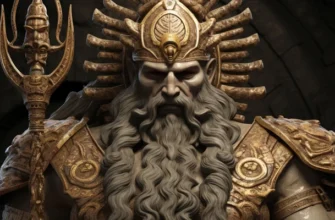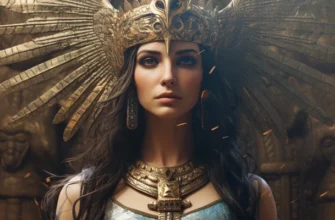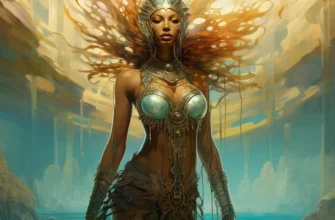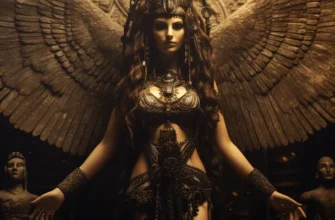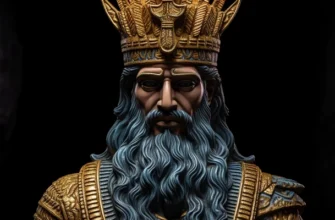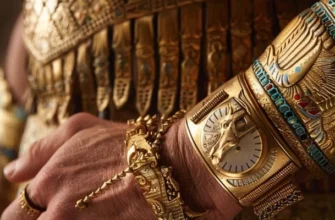Inanna is a recognized goddess of love, war and fertility in Sumerian mythology. As the daughter of Anu and Ki, she embodies the power of nature and feminine energy. Her attributes include shrines and symbols that emphasize her power. Inanna plays a key role in the divine aspects of love and war, as well as fertility and agriculture. The famous myth of her descent into the underworld reveals aspects of loss and resurrection. The influence of the cult of Inanna was manifested in numerous other ancient civilizations. The goddess impresses with her diversity and importance in the Sumerian pantheon.
- Origin and Family of Inanna
- Inanna as the daughter of Anu and Ki
- Attributes and symbolism of the goddess
- Shrines of Inanna
- Images and Sacred Images
- Role in Sumerian society
- Inanna’s role in aspects of love and war
- Inanna as the patroness of fertility
- Myths about Inanna, the Sumerian Goddess
- Myth of the Descent to the Underworld
- The Myth of the Creation of Man
- The Myth of Love and the Return to Life
- The Myth of Oblivion
- Influence on other cultures
- Considering the influence of the cult of Inanna on other ancient civilizations
- Conclusion
Origin and Family of Inanna
Inanna, the Sumerian goddess, was born from the majestic union between Anu, the god of the sky, and Ki, the goddess of the earth. Her origin is traced back to the high pantheon of Sumerian deities, where her father Anu wields the highest power and her mother Ki is the living and fertile force of nature.
Inanna is derived from this divine lineage, endowed with a special status and power. Her origins determine her important role in Sumerian mythology as the goddess of love, war, and fertility. She has a key role in the divine world of ancient Sumer.
Inanna as the daughter of Anu and Ki
In Sumerian mythology, Inanna was considered the daughter of Anu and Ki, who were the highest deities in the pantheon. Here are some key aspects of her family status:
- Father – Anu: Anu, also known as An, was the god of the sky and the supreme ruler of the Sumerian pantheon. As Inanna’s father, Anu had great status in the world of the gods and wielded great power.
- The mother was Ki: Ki, or Kishar, represented the earth and was the wife of Anu. Her union with Anu symbolized the union of the heavenly and the earthly. Inanna, as their daughter, combined the properties of both the heavenly and earthly worlds.
- Family tree and brothers: Inanna had various siblings in the Sumerian pantheon, including the god Enlil. Family ties in mythology played an important role in determining the roles and power of various deities.
- Family and Religious Aspects: The interactions between Anu, Ki, and Inanna reflected various aspects of Sumerian cosmogony and religious system. Family ties provided the basis for the gods’ interaction in creating and maintaining the world.
Thus, Inanna acted as the daughter of the great deities Anu and Ki, which gave her an important place in the Sumerian pantheon and determined her role in the cosmogonic and mythological fabric of this ancient civilization.
Attributes and symbolism of the goddess
The lioness
One of the main attributes of Inanna is her attendant, the lioness. This symbol expresses the courage and warrior power of the goddess. The lioness is also associated with power over animals and nature.
High Ceiling
Inanna is often depicted with a high ceiling, which symbolizes her power over the heavenly forces and her high status in the pantheon. This attribute emphasizes her greatness and divine energy.
The knot of life
Another important part of Inanna’s symbolism is the “knot of life” or “sacred knot”. This symbol indicates her role in the cycles of life, including birth, life, and death.
Shrines and the Image Sought
Inanna is also often associated with shrines and images, including a variety of amulets and images that were revered by her followers. These symbols are meant to invoke her blessings and protection.
Inanna’s attributes and symbolism are deeply embedded in Sumerian cultural and religious heritage, reflecting her versatile aspects and power over various spheres of life.
Shrines of Inanna
Inanna, the Sumerian goddess, had numerous shrines that played a key role in religious life and rituals. One of the most famous shrines was the city of Uruk, where her main temple, Eanna, was located. This sacred complex was considered the center of the cult of Inanna.
Temple of Eanna
The temple of Eanna in Uruk was dedicated to Inanna and was the site of major religious celebrations and rituals. It served as a center of worship where priests and worshippers gathered to honor the goddess.
Ziggurat
An important element of Inanna’s shrines were ziggurats, pyramid-like structures. Some of the most impressive ones were located in Uruz and Lagash. These structures served as places for performing rites, prayers, and rituals.
Images and Sacred Images
Inanna was often depicted on various images and amulets that were used for a cult rite so personal. Her images played an important role in Sumerian art and religious practices.
Inanna’s shrines were not only a center of faith, but also a place where the community gathered to show veneration and address the deity. These shrines became symbols of the power and worship of the great Sumerian goddess.
Role in Sumerian society
Love and War
Inanna played a key role in the realms of love and war in Sumerian society. As the goddess of love, she was called upon to stir up love and romance among the gods and humans. Her cult served as the basis for rituals aimed at increasing fertility and fertility.
Fertility and Agriculture
Inanna was also considered the patroness of fertility and agriculture. Her blessings were aimed at the harmony of nature and the flourishing of agricultural activities. She acted as a divine force that ensured productivity and prosperity.
Religious Rites and Cult
The cult of Inanna included various religious rites and festive events. Priests and worshippers performed rites in temples, including prayers, sacrifices, and processions. These rites were intended to show respect and blessings from the goddess.
Importance in Myths and Literature
Inanna’s role in Sumerian myths and literature was enormous. Her descent into the underworld and restoration was believed to control life and death, and to manifest her power and authority over all things created.
Inanna not only reflected aspects of culture and faith, but also defined norms and values in Sumerian society, making her one of the most important figures in their spiritual life.
Inanna’s role in aspects of love and war
Goddess of Love.
Inanna appears as a huge force in the field of love in the Sumerian pantheon. Her cult combined rituals and ceremonies aimed at inducing love and fertility among gods and humans. Her presence introduced an element of romance and created the basis for the perception of love as a divine power.
Protector of war
Outside of the realm of love, Inanna also played an important role in aspects of war. She was recognized as the goddess of war and protection. Her attributes, such as the lioness and the high ceiling, symbolized warrior strength and power. In times of conflict, Sumerian warriors may have turned to Inanna for blessings and protection on the battlefield.
Combination of Aspects
Inanna is unique in that she combines aspects of love and war. This striking combination made her not only an object of veneration in the hearts of lovers, but also a recognized figure for those seeking protection and support in wartime.
Inanna’s role in the aspects of love and war profoundly influenced the religious and cultural aspects of Sumerian society, giving her a defining position in the pantheon and the hearts of the faithful.
Inanna as the patroness of fertility
The cult of fertility
Inanna plays a key role in the Sumerian pantheon as the patroness of fertility. Her cult focused on promoting fertility to the land and families. She was considered a goddess who grants fertility to nature and people.
Blessing of the Harvest
Inanna initiated rituals and prayers to ensure harvest and fertility. She was intended to be an important figure for farming and agriculture, and her blessings were aimed at ensuring soil fertility and rich harvests.
The symbol of the “Knot of Life”
Inanna is often associated with the “knot of life,” a symbolic element that indicates her role in the origin and development of life. This symbol can also signify her power over the life cycle, including the birth and growth of plants.
Religious Fertility Rites
Religious rituals associated with Inanna included prayers, sowing rites, and sacrifices aimed at ensuring fertility. She was used as an intermediary between the gods and people, granting them the blessings of fertility and abundance.
Inanna, as the patroness of fertility, not only influenced natural processes, but also reflected the importance of this aspect for Sumerian society, given the dependence on fertile land for their own well-being and prosperity.
Myths about Inanna, the Sumerian Goddess
Myth of the Descent to the Underworld
This myth tells of a great act of sacrifice by Inanna, who decides to descend to the underworld to save her sister Dumuzi, who has plunged into this world. Passing through various underground gates and losing the attributes of her power symbolizes the cosmic crossing and the renewal of life cycles.
The myth of Inanna’s descent into the underworld is one of the most impressive and symbolic in Sumerian mythology. This story reveals deep and mysterious aspects of life and death, as well as the importance of self-sacrifice to restore natural cycles.
The decision to descend: The myth begins with Inanna, who, wanting to discover the secrets of the underworld, decides to go down there. She leaves her divine power behind and begins her journey through seven gates, each of which requires a certain amount of self-sacrifice.
Loss of the Attributes of Power: During her descent, Inanna removes her luxurious robes and jewelry that symbolize her power and status. At each turn, she loses something important, including her crown, necklace, and other attributes.
The grand meeting with Ereshkigal: Upon arriving in the Underworld, Inanna meets her sister Ereshkigal, the ruler of the Underworld. But Ereshkigal shows no kindness, and in anger, she imposes the death penalty on Inanna, turning her into a dead body.
Loss and Resurrection: After the loss of Inanna, the gods decide to intervene. Enkidu, the god of wisdom, creates two companions who travel to the underworld to rescue Inanna. Thanks to the mental intrigue of Enkidu and Shamash, Inanna is resurrected and returns to the surface.
Victory over Death: The resurrection of Inanna signifies the victory over death and the restoration of natural cycles. The myth serves as a symbol of eternal life and maintaining balance in the cosmic order.
The myth of Inanna’s descent into the underworld not only reveals deep philosophical aspects, but also points to the importance of self-sacrifice and resurrection in the Sumerian religious and cultural tradition.
The Myth of the Creation of Man
In another myth, Inanna, having remained on Earth, decides to create a man from clay, giving him the gift of reason. This act is considered an act of creation and defines the goddess’s role in shaping the world and the relationship between deities and humans.
The myth of the creation of man with the participation of Inanna is part of Sumerian mythology, which reveals the process of creating humanity and giving it the gift of reason. The main events of the myth can be described as follows:
Inanna’s decision: The myth begins with Inanna, the goddess of love and fertility, deciding to create something unique to complement nature and the gods.
Mining Clay: Inanna decides to use clay as the material for her creation. Clay in Sumerian symbolism often refers to the material nature of man and his perception.
Receiving Spirit from Enlil: During her creative process, Inanna decides to add something special by giving her creation a spirit or mind. She turns to Enlil, the air god and lord of the gods, to capture his spirit and breathe it into the clay figure.
The Gift of Reason: Inanna, as the beloved creative goddess, grants the created figure reason so that it can understand and appreciate its existence.
To life: After Inanna breathes her spirit into the clay figure and grants it intelligence, this new creature comes to life, gaining life and consciousness.
This myth serves as an important explanation of the origin and nature of the human being in Sumerian culture. It emphasizes the importance of mind and spirituality in the creation and evolution of human civilization.
The Myth of Love and the Return to Life
In this myth, Inanna falls in love with Dumuzi, the god of fertility. Their loving community leads to the flourishing of nature. But when winter sets in, Dumuzi leaves Inanna, leading to a gloomy time. By turning to her sisters and her father Anu, Inanna is able to revive Dumuzi, marking a reversal in the cycles of nature.
The love myth of Inanna and Dumuzi is a fascinating story about the power of love, the versatility of natural cycles, and the eternity of spiritual connection. This story has several key stages:
The meeting of Inanna and Dumuzi: Inanna, the goddess of love and fertility, meets Dumuzi, the god of fertility and shepherding, and a great love sparks between them. Their unity symbolizes the harmony of nature.
The kiss of love: Inanna and Dumuzi join forces to bring fertility and prosperity to nature. Their love blossoms like a spring flower and gives life.
Divorce and Inheritance: However, with the arrival of winter, Dumuzi must go to the underworld. Inanna, grieving for his loss, separates from him, leaving her role on Earth.
The Gloomy Season and the Resurrection: Inanna is followed by a time of darkness, where nature stands still for a time. But, thanks to Inanna’s brother, the god of wisdom Enkidu, and the decision to restore Dumuzi, winter ends and nature is reborn.
Restoration of Life Cycles: The restoration of Dumuzi symbolizes the eternal cycle of life cycles, including birth, life, death, and rebirth. The love of Inanna and Dumuzi crosses the barriers of time and death.
The myth of the love of Inanna and Dumuzi highlights important themes such as eternity, death, and the renewal of nature, making it one of the most important in Sumerian mythology.
The Myth of Oblivion
This myth describes the moment when Inanna decides to give up her divine power and destroy her attributes in order to experience life as a mortal. However, this decision leads to the oblivion of her true status. It is only with the help of the goddess of wisdom and fertility Ereshkigal that she returns to her divine role.
The myth of oblivion is a fascinating narrative that highlights the themes of self-sacrifice, loss, and the restoration of Inanna’s divine power. The main stages of this myth can be described as follows:
The decision to forget: Inanna, wanting to explore the human experience, makes the decision to give up her divine power and lose her attributes of divinity.
Renunciation of Attributes: At each of the seven gates leading to the underworld, Inanna gives up her crown, necklace, miter, and other attributes of her power. Each loss symbolizes the abandonment of a certain aspect of her divinity.
Descent into the Underworld: Inanna reaches the last gate where she must give up her last amulet, the necklace. After that, she enters the underworld.
Feelings of Forgetfulness:In the underworld, Inanna experiences the feeling of forgetting her true divinity and losing her identity.
Appeal to Ereshkigal: In order to return to the world of the living, Inanna turns to her sister Ereshkigal, the ruler of the underworld, who helps her recover her amulets and return to the living.
Return to Divine Power: Once her attributes are restored, Inanna returns to her supernatural status and her divine power.
This myth expresses important themes of loss, sacrifice, and restoration, showing how even a goddess can experience a history of human forgetfulness and loss and find a way to return to her true self.
These myths about Inanna express deep and symbolic aspects of her religious and cultural importance in Sumerian mythology.
Influence on other cultures
The Sumerian goddess Inanna had a significant impact on other cultures of her time and subsequent eras. Here are some aspects of her influence:
1. Intercultural Exchange:
Inanna was a divine figure who was the subject of deification and cult practices in Sumer and Akkadia. Her cult and myths about her passed on to other cultures of the ancient Near East, such as Babylonian, Assyrian, and Chaldean.
2. International Poetic Tradition:
Poetic works dedicated to Inanna became part of an international poetic tradition. Her myths were intertwined with other deities and literary traditions, facilitating the exchange of ideas and cultural experiences.
3. Personalization of the Feminine Divinity:
Inanna, as the goddess of love, fertility and war, has become a typical representation of female divinity. Her character and attributes can be found in other mythologies, where similar goddesses have been given attention to aspects of life related to femininity and the forces of nature.
4. Intercultural Exchange of Customs and Rituals:
Religious customs and rituals associated with Inanna may have influenced ritual practices in other cultures. Elements of her cult, such as fertility rituals and war rites, may be noted in various aspects of religion.
5. Influence on the Role of the Goddess in the Middle Ages and Beyond:
Inanna, as embedded in a rich cultural context, had an impact on the view of goddesses in the Middle Ages and later periods. Elements of her character and story can be traced back to cultures that followed the traditions of ancient Mesopotamia.
Due to her unique character and versatile role, Inanna became an important element of world mythology, influencing cultural exchange and the development of religious ideas.
Considering the influence of the cult of Inanna on other ancient civilizations
The cult of Inanna, also known as Ishtar in Western Semitic mythology, had a significant impact on other ancient civilizations of the Ancient Near East. Here are some aspects of this influence:
Babylonian and Assyrian Mythology: Babylonian and Assyrian mythologies were heavily influenced by the cult of Inanna. The Babylonian Ishtar, who resembled Inanna, became an important goddess, revered for her role in love, war, and fertility. The epithets and attributes of Inanna were reflected in the image of Ishtar.
Phoenician and Canaanite Religion: Inanna’s influence can be traced in the Phoenician and Canaanite religion through a combination of Assyrian and Sumerian influences. The goddess Astarte, who is a similar figure, combines aspects of love and fertility and also has elements that can be linked to Inanna’s shrines.
Hittite Ishtar: In Hittite mythology, Ishtar was also influenced by the cult of Inanna. The Hittites considered Ishtar to be the goddess of love and war, similar to Inanna’s role. Knowledge about Inanna could have been transmitted through contacts between different civilizations.
Egyptian Religion: The Egyptian religion can be mentioned as one of the civilizations that experienced the influence of Inanna through intercultural exchange. There are ideas that the image of the goddess Isis, who also has aspects of love and resurrection, may have been influenced by the myths of Inanna.
Later Influences:Much of the influence of the cult of Inanna may be important for understanding the religions and mythologies that emerged from the development of ancient civilizations. For example, religious and mythological elements that arose from this influence can be seen in the writings of Judaism, Christianity, and Islam.
The influence of the cult of Inanna was far-reaching, cutting across cultural boundaries and contributing to the development of religious ideas in Sumer and beyond.
Conclusion
In conclusion, the study of the role and importance of Inanna in Sumerian mythology shows that this goddess occupied an exceptional place in the religious and cultural life of Ancient Sumer. Her multifaceted nature reflected the diversity of aspects of life and nature, making her an important symbol for the Sumerian people.
Inanna, as the goddess of love, fertility, and war, was recognized as the highest female divinity. Her cult had a significant impact on religious and cultural traditions not only in Sumer but also in neighboring civilizations, indicating a deep intercultural exchange and mutual influence in ancient times.
The myths about Inanna, including her descent into the underworld and her restoration, are striking in their symbolism and philosophical depth. They not only reveal the dynamics of natural cycles, but also point to the importance of self-sacrifice and renewal in religious experience.
Inanna influenced the formation of ideas about female divinity and its role in the worldview. Her image became the primary source for further religious concepts and mythological images, taking on new forms and interpretations in different cultures and epochs.
Thus, Inanna, as a goddess who combines various aspects of life and death, love and war, fertility and fruitfulness, remains an integral part of the world’s cultural heritage, inspiring people of different eras and nations to reflect on the deep and universal aspects of existence.

